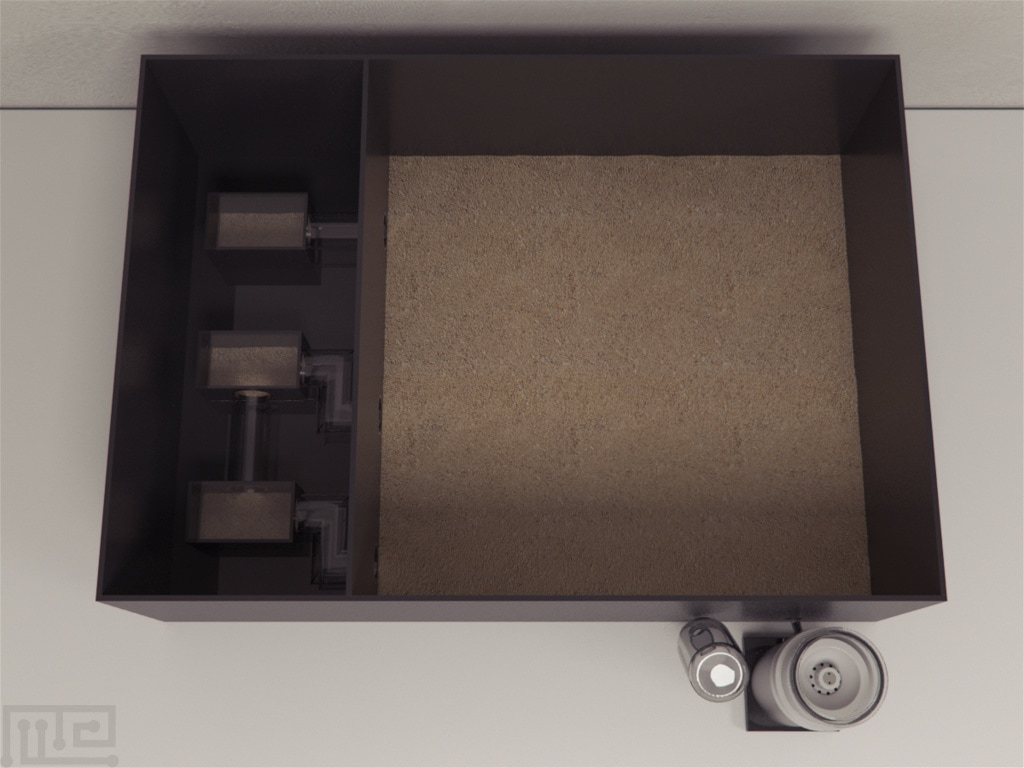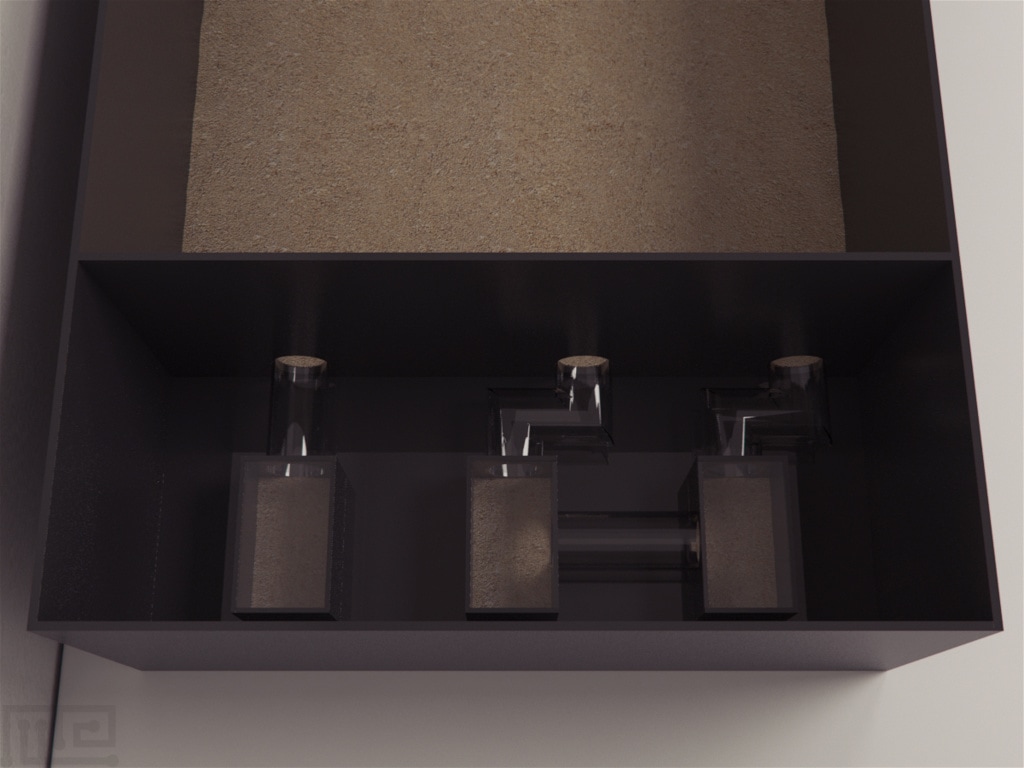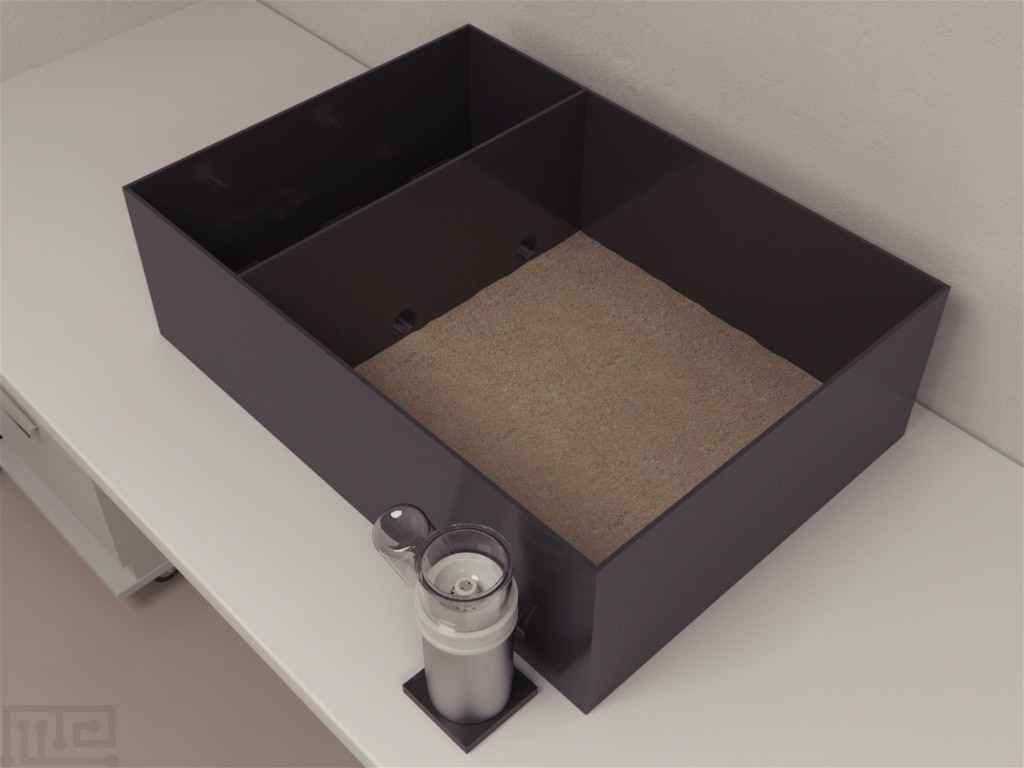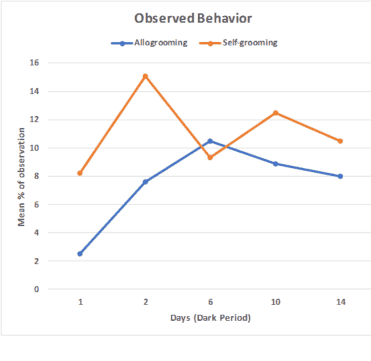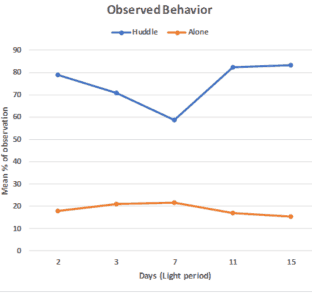Each colony in the Visual Burrow System is housed in a rectangular acrylic chamber. Three chambers are positioned behind a barrier wall in the burrow area, with a wall separating it from the open area. These chambers are connected to and opened through the wall via clear Plexiglas tubes. Two of the three chambers, each connected to the “surface” area via a “Z” shaped tube, are connected to each other via a straight clear Plexiglas tube. The third chamber is connected only to the surface, via a straight tube. The animals are allowed to pass freely between each chamber and the “surface” area, or between the two connected chambers, by these tubes. Food hoppers and water tubes are located in a far corner of the surface open area. All dividing walls and chambers are constructed of black Plexiglas. The roof of the chamber is made of clear Plexiglas to permit videotaping. The floor can be covered by a layer of sawdust bedding (1 cm) in all chambers as well as the surface for experimentation (not included).
Sizing for mice and rats.
Price & Dimensions
Mouse
$ 2490
Per Month- Mouse Chamber: 86 cm x 61 cm x 26 cm (L x W x H)
- Burrow area: 25 cm x 61 cm x 26cm (L x W x H)
- Three chambers (located in burrow area): 12 cm x 7 cm x 6 cm (L x W x H)
- Open Area: Burrow area: 61 cm x 61 cm x 26cm (L x W x H)
- Tube Diameter (3): 5cm
Rat
$ 2290
Per Month- Rat Chamber: 129 cm x 92 cm x 39 cm (L x W x H)
- Burrow area: 38 cm x 92 cm x 39cm (L x W x H)
- Three chambers (located in burrow area): 18 cm x 1 cm x 9 cm (L x W x H)
- Open Area: Burrow area: 92 cm x 92 cm x 39cm (L x W x H)
- Tube Diameter (3): 7.5 cm
Documentation
Introduction
The Visual Burrow System (VBS) was developed by Bob Blanchard and Caroline Blanchard in the late 1980’s. The VBS is commonly used in the evaluation of social behaviors. The apparatus mimics the natural environment of the rodents, thus, enabling observation of natural social interactions that would have been otherwise impossible to observe in the wild. The VBS can be used for the observation of a variety of non-defensive behaviors such as sexual and consummatory activity, and defensive behaviors such as the effect of exposure to a threatening stimulus. Other similar social behavior task apparatus include the Social Reward Chamber and the Social Defeat Apparatus.
The Visual Burrow System consists of an open arena and a series of tunnels and burrows that create the burrow system. Rodents are known to be very social animals. The advancement in genetic manipulation makes these animal models a useful research tool. However, caution must be taken when studying colonies composed of multiple males as male aggression tends to be high in such colonies.
Apparatus and Equipment
The Visual Burrow Apparatus is housed in an 86 x 61 x 26 cm acrylic bin. A wall (61 cm in length) is placed 25 cm from the end wall to separate the open area from the burrow area. The three burrow chambers of dimensions 12 x 7 x 6 cm, each, are placed in the smaller section created by the partition. Two of these chambers are connected to each other via a straight tube and have a ‘Z’ shaped plexiglass tube connecting them to the open area through the wall. The third chamber is connected via straight plexiglass tube only to the open area. The floors of the chambers and the open area are covered with 1 cm of sawdust bedding. Food hopper and water bottle are placed in the corner of the open area.
The entire apparatus is constructed using black plexiglass except for the tubes and the chamber tops to permit video recording.
Training Protocol
The experiment room is illuminated on a 12: 12-hour light-dark cycle. For the light phase, fluorescent lamps are used while infrared lights are used in the dark phase. The temperature and humidity are also maintained at 22 ± 1 oC and 70% humidity. A video camera is positioned above the apparatus to record the social behaviors of the subjects during dark and light cycles.
Before the experiment, the subjects are first marked by hair dye for easy identification. The colonies are formed using subjects that are usually not familiar with each other and are introduced to the Visual Burrow System at the beginning of the dark cycle.
Identification of eusocial behaviors in genetic animal models of autism in a mixed colony
Colonies were formed using three females and one male subject and maintained in the Visual Burrow System for 15 days. Video recording is done for 4 hours daily, on days 1, 2, 6, 10, and 14 in the dark cycle and days 2, 3, 7, 11, and 15 in the light cycle (Arakawa et al., 2007).
Identification of eusocial behaviors in genetic animal models of autism in a male colony
Colonies were formed using three male subjects and maintained in the Visual Burrow System for 15 days. Video recording is done for 4 hours daily, on days 1, 2, 6, 10, and 14 in the dark cycle and days 2, 3, 7, 11, and 15 in the light cycle (Arakawa et al., 2007).
Sample Data
Behaviors are analyzed by time sampling with an initial 30 sec sample being taken every 10 min for each mouse. Social behaviors are scored as the observed percentage.
The following social behaviors are observed during the trials:
- Huddle: This behavior involves the subject lying in contact with another animal in the chamber for more than 10 sec of the 30 sec time sample.
- Alone: This behavior is identified as the subject being alone and maintaining a distance of 3 bodies away from the nearest neighbor for more than 10 sec of the 30 sec time sample.
- Allogrooming: The behavior of cleaning other subjects.
- Self-grooming: The behavior of cleaning oneself.
- Approach to front: This behavior is identified as an oriented movement towards the front of another subject from a distance.
- Approach to back: This behavior is identified as an oriented movement towards the back of another subject from a distance.
- Flight: This behavior is identified as a quick movement away from an approaching subject.
- Chasing: This behavior is identified as rapid locomotion towards a fleeing animal.
- Following: This behavior is identified as slow speed following another subject.
- Mounting: This behavior is determined as mounting another subject from the back and shaking its hip quickly.
- Struggling: This behavior involves vigorous activity such as rolling and biting.
- Contact: This behavior is associated with physical contact following oriented movement towards another animal. (Not counted in chambers).
Strengths & Limitations
Strengths
Earlier social behavioral assessments could not successfully recreate the burrow system that is observed in the wild among rodents. The Visual Burrow System overcame this hurdle
and allowed observation of the subjects in a semi-naturalistic setting. The VBS is an effective apparatus in the assessment of social behaviors in the different disease model, such as the autism. This apparatus, along with advancements in genetic manipulation, allows development of better treatments and in improving the understanding of social behaviors associated with diseases. The Visual Burrow System can also be used in the evaluation of antipredator defensive behaviors and the assessment of social anxiety.
Limitations
When using colonies of only males in the Visual Burrow System, high level of male aggression can be observed, which can result in the death of the subjects. External factors such as auditory disturbances could also impact the behaviors of the subject. Rearing and housing procedures can also affect the interactions.
Summary and Key Points
- The Visual Burrow System (VBS) was developed by Bob and Caroline Blanchard in the late 1980’s.
- The VBS mimics the natural environment of the rodents.
- The VBS enables observation of natural social interactions as it would happen in the wild.
- The VBS can be used for observation of a variety of non-defensive and defensive behaviors.
- Male aggression tends to be high in colonies composed of multiple males.
References
Arakawa H, Blanchard DC, Blanchard RJ (2007). Colony formation of C57BL/6J mice in visible burrow system: identification of eusocial behaviors in a background strain for genetic animal models of autism. Behav Brain Res. 176(1):27-39.
Blanchard RJ, Blanchard DC (1989). Antipredator defensive behaviors in a visible burrow system. J Comp Psychol. 103(1):70-82.

